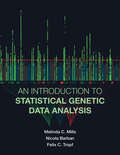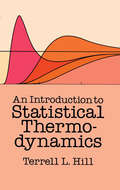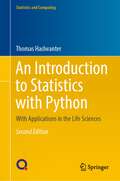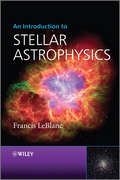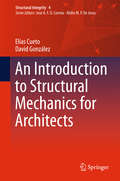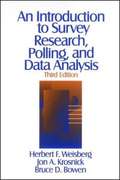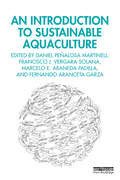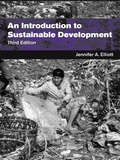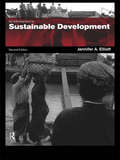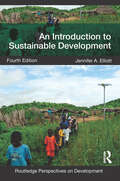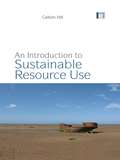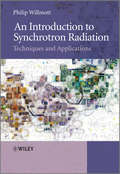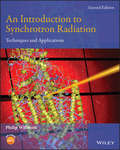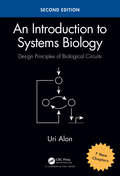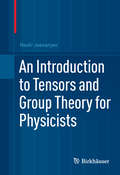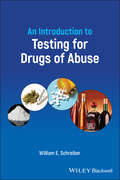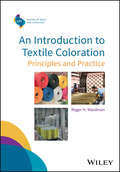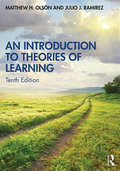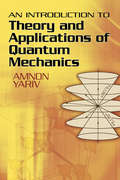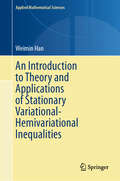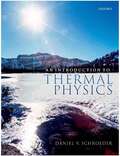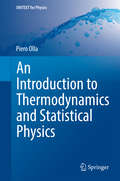- Table View
- List View
An Introduction to Statistical Genetic Data Analysis (The\mit Press Ser.)
by Melinda C. Mills Nicola Barban Felix C. TropfA comprehensive introduction to modern applied statistical genetic data analysis, accessible to those without a background in molecular biology or genetics.Human genetic research is now relevant beyond biology, epidemiology, and the medical sciences, with applications in such fields as psychology, psychiatry, statistics, demography, sociology, and economics. With advances in computing power, the availability of data, and new techniques, it is now possible to integrate large-scale molecular genetic information into research across a broad range of topics. This book offers the first comprehensive introduction to modern applied statistical genetic data analysis that covers theory, data preparation, and analysis of molecular genetic data, with hands-on computer exercises. It is accessible to students and researchers in any empirically oriented medical, biological, or social science discipline; a background in molecular biology or genetics is not required.The book first provides foundations for statistical genetic data analysis, including a survey of fundamental concepts, primers on statistics and human evolution, and an introduction to polygenic scores. It then covers the practicalities of working with genetic data, discussing such topics as analytical challenges and data management. Finally, the book presents applications and advanced topics, including polygenic score and gene-environment interaction applications, Mendelian Randomization and instrumental variables, and ethical issues. The software and data used in the book are freely available and can be found on the book's website.
An Introduction to Statistical Thermodynamics (Dover Books On Physics Series)
by Terrell L. HillAlthough written on an introductory level, this wide-ranging text provides extensive coverage of topics of current interest in equilibrium statistical mechanics. Indeed, certain traditional topics are given somewhat condensed treatment to allow room for a survey of more recent advances.The book is divided into four major sections. Part I deals with the principles of quantum statistical mechanics and includes discussions of energy levels, states and eigenfunctions, degeneracy and other topics. Part II examines systems composed of independent molecules or of other independent subsystems. Topics range from ideal monatomic gas and monatomic crystals to polyatomic gas and configuration of polymer molecules and rubber elasticity. An examination of systems of interacting molecules comprises the nine chapters in Part Ill, reviewing such subjects as lattice statistics, imperfect gases and dilute liquid solutions. Part IV covers quantum statistics and includes sections on Fermi-Dirac and Bose-Einstein statistics, photon gas and free-volume theories of quantum liquids.Each chapter includes problems varying in difficulty — ranging from simple numerical exercises to small-scale "research" propositions. In addition, supplementary reading lists for each chapter invite students to pursue the subject at a more advanced level. Readers are assumed to have studied thermodynamics, calculus, elementary differential equations and elementary quantum mechanics.Because of the flexibility of the chapter arrangements, this book especially lends itself to use in a one-or two-semester graduate course in chemistry, a one-semester senior or graduate course in physics or an introductory course in statistical mechanics.
An Introduction to Statistics with Python: With Applications in the Life Sciences (Statistics and Computing)
by Thomas HaslwanterNow in its second edition, this textbook provides an introduction to Python and its use for statistical data analysis. It covers common statistical tests for continuous, discrete and categorical data, as well as linear regression analysis and topics from survival analysis and Bayesian statistics.For this new edition, the introductory chapters on Python, data input and visualization have been reworked and updated. The chapter on experimental design has been expanded, and programs for the determination of confidence intervals commonly used in quality control have been introduced. The book also features a new chapter on finding patterns in data, including time series. A new appendix describes useful programming tools, such as testing tools, code repositories, and GUIs.The provided working code for Python solutions, together with easy-to-follow examples, will reinforce the reader’s immediate understanding of the topic. Accompanying data sets and Python programs are also available online. With recent advances in the Python ecosystem, Python has become a popular language for scientific computing, offering a powerful environment for statistical data analysis.With examples drawn mainly from the life and medical sciences, this book is intended primarily for masters and PhD students. As it provides the required statistics background, the book can also be used by anyone who wants to perform a statistical data analysis.
An Introduction to Stellar Astrophysics
by Francis LeblancAn Introduction to Stellar Astrophysics aspires to provide the reader with an intermediate knowledge on stars whilst focusing mostly on the explanation of the functioning of stars by using basic physical concepts and observational results.The book is divided into seven chapters, featuring both core and optional content:Basic conceptsStellar FormationRadiative Transfer in StarsStellar AtmospheresStellar InteriorsNucleosynthesis and Stellar Evolution andChemically Peculiar Stars and Diffusion.Student-friendly features include:Detailed examples to help the reader better grasp the most important conceptsA list of exercises is given at the end of each chapter and answers to a selection of these are presented.Brief recalls of the most important physical concepts needed to properly understand stars.A summary for each chapterOptional and advanced sections are included which may be skipped without interfering with the flow of the core content.This book is designed to cover the most important aspects of stellar astrophysics inside a one semester (or half-year) course and as such is relevant for advanced undergraduate students following a first course on stellar astrophysics, in physics or astronomy programs. It will also serve as a basic reference for a full-year course as well as for researchers working in related fields.
An Introduction to Stochastic Processes in Physics
by Don S. LemonsThis book provides an accessible introduction to stochastic processes in physics and describes the basic mathematical tools of the trade: probability, random walks, and Wiener and Ornstein-Uhlenbeck processes. It includes end-of-chapter problems and emphasizes applications.An Introduction to Stochastic Processes in Physics builds directly upon early-twentieth-century explanations of the "peculiar character in the motions of the particles of pollen in water" as described, in the early nineteenth century, by the biologist Robert Brown. Lemons has adopted Paul Langevin's 1908 approach of applying Newton's second law to a "Brownian particle on which the total force included a random component" to explain Brownian motion. This method builds on Newtonian dynamics and provides an accessible explanation to anyone approaching the subject for the first time. Students will find this book a useful aid to learning the unfamiliar mathematical aspects of stochastic processes while applying them to physical processes that he or she has already encountered.
An Introduction to Stochastic Processes in Physics: Containing On The Theory Of Brownian Motion By Paul Langevin, Translated By Anthony Gythiel
by Don S. LemonsThis “lucid, masterfully written introduction to an often difficult subject . . . belongs on the bookshelf of every student of statistical physics” (Dr. Brian J. Albright, Applied Physics Division, Los Alamos National Laboratory).This book provides an accessible introduction to stochastic processes in physics and describes the basic mathematical tools of the trade: probability, random walks, and Wiener and Ornstein-Uhlenbeck processes. With an emphasis on applications, it includes end-of-chapter problems. Physicist and author Don S. Lemons builds on Paul Langevin’s seminal 1908 paper “On the Theory of Brownian Motion” and its explanations of classical uncertainty in natural phenomena. Following Langevin’s example, Lemons applies Newton’s second law to a “Brownian particle on which the total force included a random component.” This method builds on Newtonian dynamics and provides an accessible explanation to anyone approaching the subject for the first time. This volume contains the complete text of Paul Langevin’s “On the Theory of Brownian Motion,” translated by Anthony Gythiel.
An Introduction to Structural Mechanics for Architects (Structural Integrity #4)
by Elías Cueto David GonzálezThis textbook offers an introductory course to structural mechanics for architects, including problems and solutions. It follows a completely different approach to structural mechanics than the usual books for engineering schools, making it much more attractive for architecture students and practitioners. It also offers a different point of view for engineering students, as it provides them with a more intuitive understanding of structural mechanics and the models therein.Instead of studying the classical theory of linear elasticity and then particularizing it to simple structures, this book analyzes structures in a historic and also typological order. The book starts with cable structures and stone arches, followed by trusses and, finally, frame structures made of beams. For every typology, the latest, state-of-the-art theory in the field is introduced in a very didactic way.
An Introduction to Survey Research, Polling, and Data Analysis (3rd edition)
by Herbert F. Weisberg Jon A. Krosnick Bruce D. BowenExplains how surveys are conducted, how to read statistical reports, and how to analyze data, and provides guidelines for evaluating polls. Coverage includes understanding tables, interval statistics, survey design, sampling and question-writing, interviewing and coding strategies, analysis of different types of surveys, and reading and writing reports. Includes chapter exercises and answers. Paper edition (unseen), $25. 95. Annotation c. by Book News, Inc. , Portland, Or.
An Introduction to Sustainable Aquaculture
by Daniel Peñalosa Martinell Vergara-Solana, Francisco J Araneda Padilla, Marcelo E Fernando Aranceta GarzaThis new textbook provides an accessible introduction to sustainable aquaculture through its relationship with three key pillars: the environment, the economy, and society.As the demand for seafood keeps increasing, aquaculture is considered one of the most promising and sustainable ways to satisfy this demand with nutritious and high-quality food. It is important to understand, therefore, the wider role and impact aquaculture has on the environment, the economy, and society. The book begins by providing a foundational introduction to aquaculture and sustainability, discussing the complex and interdependent relationship that exists between the two. The core text of the book is divided into four parts which focus on the environment, economics, social impacts, and governance and technologies. Chapters examine key issues surrounding climate change, food security, new technologies, bioeconomics and risk analysis, international cooperation, employment, and animal welfare, with the book concluding with a chapter examining the future directions and challenges for the aquaculture industry. The book draws on global case studies and each chapter is accompanied by recommended reading and chapter review questions to support student learning.This book will serve as an essential guide for students of aquaculture, fisheries management, and sustainable food, as well as practitioners and policymakers engaged in sustainable fishery development.
An Introduction to Sustainable Development
by Jennifer ElliottThis third edition of a successful, established text provides a concise and well-illustrated introduction to the ideas behind, and the practices flowing from the notion of sustainable development.
An Introduction to Sustainable Development
by Jennifer ElliottThis third edition of a successful, established text provides a concise and well-illustrated introduction to the ideas behind, and the practices flowing from the notion of sustainable development.
An Introduction to Sustainable Development (Routledge Perspectives on Development)
by Jennifer ElliottThis fourth edition has been comprehensively rewritten and updated to provide a concise, well illustrated and accessible introduction to the characteristics, challenges and opportunities of sustainable development with particular reference to developing countries. The contested nature of sustainable development is explored through a detailed consideration of changing ideas and practices within environmentalism and development thinking. The text identifies the different actors involved (from institutions of global governance through to community based organisations), the policies and mechanisms through which sustainable development is being sought and considers the outcomes for particular groups and environments in both rural and urban contexts. ?? This edition places stronger emphasis on the global challenges of sustainable development with an understanding of inter-linked crises in climate, energy, economy, poverty and social injustice. It explores how these issues are leading to deep questioning of what sustainable development is, what it should be, and how sustainable development policies and mechanisms are being reconsidered. The book gives new consideration to the challenge of achieving lower carbon growth, climate adaptation, and the implications on sustainable development of rapidly expanding economies, including China and India. It contains greater discussion of how civil society movements influence outcomes of international climate policy, as well as technological developments in energy and agriculture. The text also contains a substantially expanded discussion of how poverty remains central to sustainable development challenges, as revealed through the Millennium Ecosystem Assessment and Millennium Development Goals. This invaluable text retains the core message that sustainable development has become central to debates about environment and development. Containing a substantial number of new boxed case studies, learning outcomes, chapter summaries, discussion questions, further reading and websites, this text provides an essential introduction for students.
An Introduction to Sustainable Resource Use
by Callum HillThis book explores the challenges our society faces in making the transition to renewable resource use in a way that is truly sustainable – environmentally, economically and socially. After exploring the physical limits the laws of thermodynamics impose on resource exploitation, the book outlines options for managing resources within these limits. It then moves on to look at the resources themselves (from fossil fuels, through minerals to renewable resources such as timber) and the salient question of how the relentless increase in consumption is putting untenable strain on resource use. Case studies investigate what is being done across a range of sectors – and what is and isn't working. The second half of the book turns to solutions, from the promise of industrial ecology to a new economy based on renewable resources such as biobased materials from agricultural crops and forests. Suitable for under- and postgraduate courses on environmental limits and resource use, and continuing professional development – particularly resource management, materials, industrial ecology, energy, resource economics and engineering.
An Introduction to Synchrotron Radiation
by Philip WillmottThis book introduces the reader to the basic concepts of the generation and manipulation of synchrotron light, its interaction with matter, and the application of synchrotron light in the "classical" techniques, while including some of the most modern technological developments. As much as possible, complicated mathematical derivations and formulas are avoided. A more heuristic approach is adopted, whereby the general physical reasoning behind the equations is highlighted.Key features:A general introduction to synchrotron radiation and experimental techniques using synchrotron radiation Contains many detailed "worked examples" from the literature Of interest for a broad audience - synchrotrons are possibly one of the best examples of multidisciplinary research Four-colour presentation throughout
An Introduction to Synchrotron Radiation: Techniques and Applications
by Philip Willmott PhDThe updated guide to the fundamental concepts, techniques and applications of synchrotron radiation and its applications in this rapidly developing field Synchrotron light is recognized as an invaluable research tool by a broad spectrum of scientists, ranging from physicists to biologists and archaeologists. The comprehensively revised second edition of An Introduction to Synchrotron Radiation offers a guide to the basic concepts of the generation and manipulation of synchrotron light, its interaction with matter and the application of synchrotron light in x-ray scattering, spectroscopy, and imaging. The author, a noted expert in the field, reviews the fundamentals of important experimental methods, and explores the most recent technological advances in both the latest generation of x-ray sources and x-ray instrumentation. Designed to be an accessible resource, the book contains full-colour illustrations of the underlying physics and experimental applications, as well as the most commonly-used synchrotron techniques. In particular, the updated second edition now includes: In-depth descriptions of the latest x-ray-source technologies, notably diffraction-limited storage rings and x-ray free-electron lasers The latest advances in instrumentation, x-ray optics, and experimental methods in synchrotron radiation The most recent developments in macromolecular crystallography, time-resolved studies, and imaging techniques A comprehensive set of problems for each chapter, plus their ideal solutions in the appendices. Written for undergraduate and postgraduate students from all areas of the natural and physical sciences, An Introduction to Synchrotron Radiation, Second Edition is an invaluable up-to-date reference source in this highly multidisciplinary field.
An Introduction to Systems Biology: Design Principles of Biological Circuits, Second Edition (Chapman & Hall/CRC Mathematical and Computational Biology)
by Uri AlonPraise for the first edition: … superb, beautifully written and organized work that takes an engineering approach to systems biology. Alon provides nicely written appendices to explain the basic mathematical and biological concepts clearly and succinctly without interfering with the main text. He starts with a mathematical description of transcriptional activation and then describes some basic transcription-network motifs (patterns) that can be combined to form larger networks. – Nature [This text deserves] serious attention from any quantitative scientist who hopes to learn about modern biology … It assumes no prior knowledge of or even interest in biology … One final aspect that must be mentioned is the wonderful set of exercises that accompany each chapter. … Alon’s book should become a standard part of the training of graduate students. – Physics Today Written for students and researchers, the second edition of this best-selling textbook continues to offer a clear presentation of design principles that govern the structure and behavior of biological systems. It highlights simple, recurring circuit elements that make up the regulation of cells and tissues. Rigorously classroom-tested, this edition includes new chapters on exciting advances made in the last decade. Features: Includes seven new chapters The new edition has 189 exercises, the previous edition had 66 Offers new examples relevant to human physiology and disease
An Introduction to Tensors and Group Theory for Physicists
by Nadir JeevanjeeAn Introduction to Tensors and Group Theory for Physicists provides both an intuitive and rigorous approach to tensors and groups and their role in theoretical physics and applied mathematics. A particular aim is to demystify tensors and provide a unified framework for understanding them in the context of classical and quantum physics. Connecting the component formalism prevalent in physics calculations with the abstract but more conceptual formulation found in many mathematical texts, the work will be a welcome addition to the literature on tensors and group theory. Advanced undergraduate and graduate students in physics and applied mathematics will find clarity and insight into the subject in this textbook.
An Introduction to Testing for Drugs of Abuse
by William E. SchreiberAn Introduction to Testing for Drugs of Abuse An Introduction to Testing for Drugs of Abuse presents a distilled set of facts about the major drugs of abuse that are encountered in clinical practice. Individual chapters highlight the similarities in chemical structure, mechanism of action, and physiologic effects of each drug group, as well as their metabolism, therapeutic uses and potential for misuse or abuse. Special attention is given to the testing process, with an emphasis on interpretation of test results. Informative and entertaining cases appear at the end of each chapter. These cases illustrate the many situations in which drug testing is performed for medical, legal and employment purposes. Written in clear, concise language, this book provides practical guidance to pathologists, clinical chemists and technologists who are responsible for reporting and interpreting the results of drug analyses. It will be especially useful to residents and students who are learning about toxicology for the first time. Clinical practitioners – doctors, nurses, pharmacists and other health care professionals – will find the information they need to order and interpret drug tests accurately.
An Introduction to Textile Coloration: Principles and Practice
by Roger H. WardmanAn Introduction to Textile Coloration: Principles and Practice The Publications Committee of the Society of Dyers and Colourists (SDC) has been aware for some time of the need to produce a book at an introductory level aimed at personnel working in textile dyeing or printing companies as well as those interested in entering into the field. The SDC runs a course for dyehouse technicians leading to the award of its Textile Coloration Certificate and this book is intended to be helpful for candidates following the course. Additionally, it will be helpful for professionals in textile companies who do not have a strong scientific background, so that they may attain a better understanding of the chemical principles of colour application. Starting with the basic science underlying dyeing and printing processes, this comprehensive book explains the fundamentals of dye and pigment chemistry and the various application techniques and processes. It offers chapter coverage of the general chemistry related to textiles, textile fibres, chemistry of dyes and pigments, industrial coloration methods, textile printing, theoretical aspects of dyeing, the measurement of colour and fastness testing. Reference is made to developments that have taken place in the coloration industry in recent years, not least of which have been the challenges imposed by the drive towards environmentally-friendly processes and restrictions on the use of certain chemicals. An Introduction to Textile Coloration: Principles and Practice Covers atomic structure, chemical reactions, and acids, bases, and salts Explains the nature of fibre-forming polymers and the conversion of synthetic polymers into fibre filaments Educates on the classification of colorants and the commercial naming of dyes and pigments Introduces readers to the dye application processes and dyeing machinery Instructs on dye aggregation, factors affecting colour appearance, the principles of colour fastness testing, and more
An Introduction to Theories of Learning
by Matthew H. Olson Julio J. RamirezSince its first edition, An Introduction to Theories of Learning has provided a uniquely sweeping review of the major learning theories from the 20th century that profoundly influenced the field of psychology. In this tenth edition, the authors present further experimental evidence that tests many of the fundamental ideas presented in these classic theories, as well as explore many of the advances in psychological science and neuroscience that have yielded greater insight into the processes that underlie learning in human beings and animals. The four main goals of this text are to define learning and to show how the learning process is studied (Chapters 1 and 2), to place learning theory in historical perspective (Chapter 3), and to present essential features of the major theories of learning with implications for educational practices (Chapters 4 through 16). The authors retained the best features of earlier editions while making revisions that reflect current research and scholarship, including coverage of active learning and the testing effect, information for problem solving in ravens, data illustrating the neurobiological basis of the cognitive map and spatial learning, new research on brain plasticity and its role in learning as well as the impact of poverty on brain and cognitive development, and new evidence that challenges the notion of learning styles. Complete with chapter summaries, discussion questions, glossary, and online resources for instructors, this text is essential reading for theories of learning and applied cognitive psychology courses.
An Introduction to Theory and Applications of Quantum Mechanics (Dover Books on Physics)
by Amnon YarivBased on a California Institute of Technology course, this outstanding introduction to formal quantum mechanics is geared toward advanced undergraduates in applied physics. The text addresses not only the basic formalism and related phenomena but also takes students a step further to a consideration of generic and important applications. The treatment's exploration of a wide range of topics culminates in two eminently practical subjects, the semiconductor transistor and the laser. Subjects include operators, Eigenvalue problems, the harmonic oscillator, angular momentum, matrix formulation of quantum mechanics, perturbation theory, the interaction of electromagnetic radiation with atomic systems, and absorption and dispersion of radiation in atomic media.Additional topics include laser oscillation, quantum statistics, applications of the statistical distribution laws, the interaction of electrons and nuclei with magnetic fields, and charge transport in semiconductors. Each chapter concludes with a set of problems.
An Introduction to Theory and Applications of Stationary Variational-Hemivariational Inequalities (Applied Mathematical Sciences #220)
by Weimin HanThis book offers a comprehensive and accessible introduction to the mathematical theory of stationary Variational-Hemivariational Inequalities (VHIs), a rapidly growing area of research with significant applications in science and engineering. Unlike traditional approaches that rely heavily on abstract inclusion results for pseudomonotone operators, this work presents a more user-friendly method grounded in basic Functional Analysis. VHIs include variational inequalities and hemivariational inequalities as special cases. The book systematically categorizes and names different VHIs, making it easier for readers to understand the specific problems being addressed. Designed for graduate students and researchers in mathematics, physical sciences, and engineering, this monograph not only provides a concise review of essential materials in Sobolev spaces, convex analysis, and nonsmooth analysis but also delves into applications in contact and fluid mechanics. Through detailed explanations and practical examples, the book bridges the gap between theory and practice, making the complex subject of VHIs more approachable. By focusing on the well-posedness of various forms of VHIs and extending the analysis to include mixed VHIs for the Stokes and Navier-Stokes equations, this book serves as an essential resource for anyone interested in the modeling, analysis, numerical solutions, and real-world applications of VHIs.
An Introduction to Thermal Physics
by Daniel SchroederThermal physics deals with collections of large numbers of particles - typically 10 to the 23rd power or so. Examples include the air in a balloon, the water in a lake, the electrons in a chunk of metal, and the photons given off by the sun. We can't possibly follow every detail of the motions of so many particles. So in thermal physics we assume that these motions are random, and we use the laws of probability to predict how the material as a whole ought to behave. Alternatively, we can measure the bulk properties of a material, and from these infer something about the particles it is made of. This book will give you a working understanding of thermal physics, assuming that you have already studied introductory physics and calculus. You will learn to apply the general laws of energy and entropy to engines, refrigerators, chemical reactions, phase transformations, and mixtures. You will also learn to use basic quantum physics and powerful statistical methods to predict in detail how temperature affects molecular speeds, vibrations of solids, electrical and magnetic behaviors, emission of light, and exotic low-temperature phenomena. The problems and worked examples explore applications not just within physics but also to engineering, chemistry, biology, geology, atmospheric science, astrophysics, cosmology, and everyday life.
An Introduction to Thermodynamics and Statistical Mechanics
by Keith StoweThis introductory textbook for standard undergraduate courses in thermodynamics has been completely rewritten. Starting with an overview of important quantum behaviours, the book teaches students how to calculate probabilities, in order to provide a firm foundation for later chapters. It introduces the ideas of classical thermodynamics and explores them both in general and as they are applied to specific processes and interactions. The remainder of the book deals with statistical mechanics - the study of small systems interacting with huge reservoirs. The changes to this 2007 second edition have been made after more than 10 years classroom testing and student feedback. Each topic ends with a boxed summary of ideas and results, and every chapter contains numerous homework problems, covering a broad range of difficulties. Answers are given to odd numbered problems, and solutions to even problems are available to instructors at www. cambridge. org/9780521865579.
An Introduction to Thermodynamics and Statistical Physics (UNITEXT for Physics)
by Piero OllaThis textbook offers an advanced undergraduate or initial graduate level introduction to topics such as kinetic theory, equilibrium statistical mechanics and the theory of fluctuations from a modern perspective. The aim is to provide the reader with the necessary tools of probability theory and thermodynamics (especially the thermodynamic potentials) to enable subsequent study at advanced graduate level. At the same time, the book offers a bird's eye view on arguments that are often disregarded in the main curriculum courses. Further features include a focus on the interdisciplinary nature of the subject and in-depth discussion of alternative interpretations of the concept of entropy. While some familiarity with basic concepts of thermodynamics and probability theory is assumed, this does not extend beyond what is commonly obtained in basic undergraduate curriculum courses.
